
Grey Matters magazine – January 2022
Grey Matters magazine – October 2021

Grey Matters magazine – September 2021
Grey Matters magazine – August 2021
Tremex – Tremex columba – Siricides
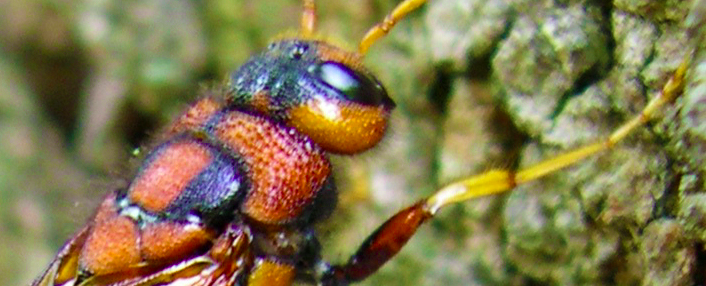
The tremex looks like an elongated, cylindrical wasp . Its thorax is reddish-brown and its abdomen has yellow and black stripes. The coloring of the wings varies from amber brown to black. Adults of both sexes have sharp appendages at the end of the abdomen. The female also has a slender, elongated egg-laying organ called an ovipositor. The adult insect is between 2.5 and 5 cm long, the female being a little larger than the male.
The white larva has a light brown head and a black thorn at the end of the abdomen. Its legs are poorly developed. It reaches 5 cm long.
Life cycle
After mating, the female lays eggs in weakened or dead trees. She uses her ovipositor to deposit her eggs under the bark. This egg-laying organ sometimes gets stuck in the tree causing the death of the female trapped on the trunk.
During the laying, a fungus is also introduced into the wood. The presence of this fungus, Cerrena unicolor , is necessary for the full development of tremex. It is said that this fungus and tremex live in symbiosis, since their association is beneficial to both species.
The larvae dig long galleries in the wood to feed. As there are no holes to expel the sawdust, it accumulates in the galleries. The tremex spends about a year as a larva, then three to five weeks as a pupa. It then transforms into an adult, who cuts a perfectly round exit hole in the bark measuring 3 mm in diameter.
In total, the life cycle of tremex usually lasts 2 years.
Geographical distribution
This species is found in southern Canada in most provinces, as well as in several US states.
Host plants
The female lays eggs in the wood of several species of deciduous trees (beech, maple, elm, walnut, oak, apple, pear, etc.).
Food
The tremex larva feeds on the wood of several deciduous tree species that serves as host plants. It also feeds on a microscopic fungus, C. unicolor , which the female introduces into the tree when laying eggs.
What you need to know
Reaching 5 cm in length, not counting the ovipositor, the tremex is the largest of the Hymenoptera .
This insect does not sting or bite.
Tremex larvae are often parasitized by Black Rhysse , an insect of the ichneumonid family. The female rhysse has a very long ovipositor. Able to detect the presence of tremex larvae under the bark, it pierces the wood to lay its eggs on its host. After hatching, the rhysis larva feeds on the tremex larva, causing its death.
Ecological roles
Although the larvae of this species feed on wood, the host trees are usually already depleted. According to some authors, the presence of this insect has little effect on tree health. Others consider T. columba to be a forest pest of notable importance.
Siricides

Siricides are similar to wasps . Adults have a massive, cylindrical black or metallic blue body. They are 2.5 to 4 cm long. Males are generally smaller, but more colorful than females. Sometimes they have yellow or red markings. They have four translucent wings and their flight is powerful and skillful.
In both sexes, the tip of the abdomen ends in a lance-shaped appendage, hence their English name horntails. The female also has a slender, elongated egg-laying organ, called an ovipositor, at the end of the abdomen. The whitish larvae have a soft body and can measure up to 4.5 cm.
Life cycle
After mating, the female searches for dying or recently cut trees. Using her egg-laying organ, the ovipositor, she deposits her eggs one by one, about 2 cm below the surface. A female produces 300 to 400 eggs which will hatch three to four weeks later. The larvae feed on the wood by digging tunnels for two years sometimes longer, then they transform into pupae.
Pupation takes place in a tunnel, just under the bark, sheltered by a cocoon made by the larva. The adult emerges in late summer.
What you need to know
Despite their sharp appendages, siricides do not sting. They don’t bite either.
This family has about 150 species.
Ecological roles
Even though their larvae feed on wood, siricides are rarely in sufficient numbers to cause serious damage to trees. Females usually select trees in poor condition to lay their eggs. By tunneling through the wood, however, the larvae can weaken the tree and make it more vulnerable to wind breakage.
Sphex ichneumoneus – Large golden sphex – Sphex
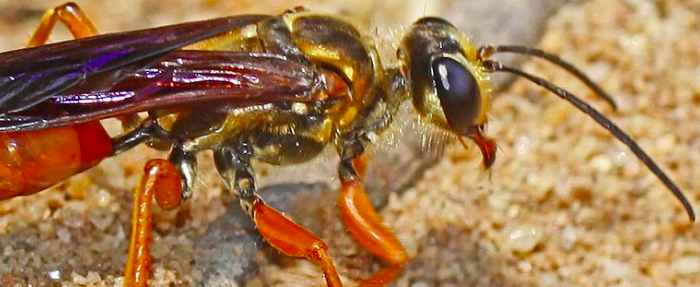
This insect owes its name to the short golden hairs that cover its thorax and head. It has black antennae and orange or amber wings. The legs are orange, except for the coxa, the part closest to the body, which is black. The large golden sphex has a slim waist and its abdomen is two-tone: orange-red for the front part and black for the rear part. Its total length is 15 to 27 mm, the male being a little smaller than the female.
Life cycle
After being fertilized, the female digs her nest in the ground. This is formed by an almost vertical central tunnel from which radiate two to six other tunnels ending in a cell intended to receive a larva. The female goes hunting and deposits prey in the cells. She then lays an egg on each of the prey, which are paralyzed, but alive. The larva that comes out of the egg feeds on the insect left by the female. There is only one generation per year.
Geographical distribution
This species is found in southern Canada, the United States and further south to Brazil, Peru and Ecuador.
Habitat
The great golden sphex lives in wasteland and meadows near which there are sandy areas.
Food
The adult feeds on flower nectar.
The larva eats the prey hunted and paralyzed by the female. These are insects belonging to the order Orthoptera, such as locusts, crickets and grasshoppers.
What you need to know
This species is sometimes gregarious and regroup a hundred individuals on the same area. This species can use the same nesting site for several years in a row.
Ecological roles
This predatory wasp plays an important role in the food chain.
Mason Pelopee – Sceliphron caementarium – Sphex
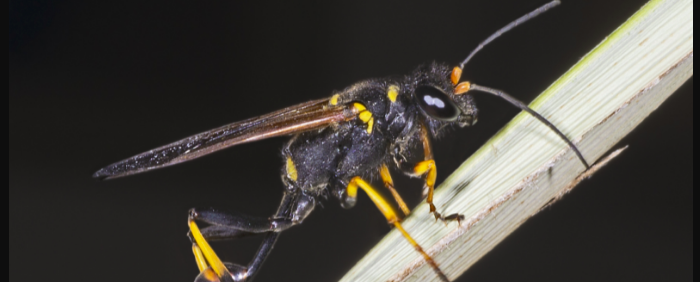
This wasp is black with yellow markings. She has a long, slender waist (pedicel) that measures about the same length as the rest of her abdomen. Its total length varies from 24 to 28 mm.
Life cycle
After mating, the female builds a mud nest. This is made up of several tubular cells the size of a date. Each of these cells is intended for a larva. When a cell is finished, the female goes on a hunt and stores enough spiders to feed the larva until its metamorphosis. A cell usually contains 6 to 15 spiders, sometimes up to 40. Live prey is paralyzed, thus constituting a reserve of fresh food. The female lays an egg on one of the spiders and then closes the cell with mud. She continues building the nest until it has about 25 cells.
The larvae develop for a few weeks then transform into pupae in their cell, where they overwinter. The adults emerge from their cells in the spring.
Geographical distribution
The Mason Pelopee is found from southern Canada to Central America and the West Indies. This species has been accidentally introduced to many countries in Europe, Australia and several islands in the Pacific.
Habitat
In the natural environment, the mason pelopee builds its nest in places sheltered from the rain. However, she can use human-made structures such as houses, attics, farms, bridges, and more.
Food
The adult feeds on nectar from the flowers of different families. This species has already been observed at hummingbird feeders.
The larvae generally feed on spiders belonging to the araneid and thomisid families.
What you need to know
The Latin name of this wasp, caementarius , means “mason, builder of walls”. The mason pelopea is able to build a nest of mud and saliva formed of several cells.
To do this, she must locate a source of building material. It is preferably clay, but mud is also suitable. The insect collects the mud using its front legs and mandibles. It incorporates saliva and forms a small soft ball that it transforms into a sliver of mud. Building a cell usually takes less than an hour and requires an average of 30 to 40 mud harvests. When the nest which is made up of several cells stuck to each other is finished, the wasp seals it by covering it entirely with an additional layer of mud.
The female emits a characteristic buzzing sound when working the mud. This sound is produced by the vibration of his flight muscles. The vibration also has the effect of liquefying the mud, which strengthens the construction.
Ecological roles
This wasp is predatory and plays an ecological role in the food chain.
Sphex
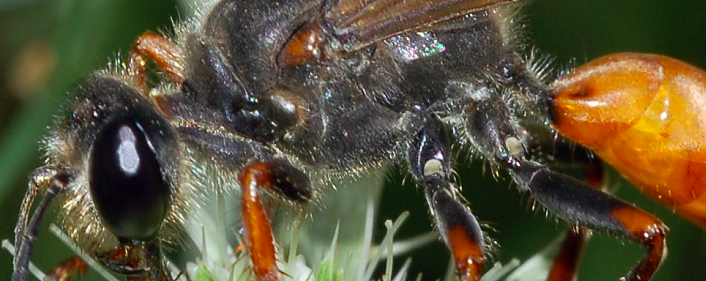
These insects vary in size (from 10 to 55 mm in length) with an elongated abdomen held in place by the thorax by a slender and slender structure in the shape of a characteristic petiole called a “wasp waist”. They can be all black or brown, or dark with white, yellow or red markings. The front legs of females often have specialized structures for digging.
The larvae are pale and have no legs.
The Sphecid family once included the crabronids, a fairly similar group of wasps that now form a full family.
Life cycle
Sphexes are holometabolous insects . Their growth cycle consists of four different stages: egg, larva, pupa and adult. The female, generally solitary in her nest, captures spiders or insects that she paralyzes with her venom. It transports them to the nest, then lays its eggs on the prey which will serve as food for the larvae.
Some species are kleptoparasites: females visit the nest of another wasp and lay eggs on preys already captured. They thus leave their eggs on the host and take no care of their larvae.
Geographical distribution
Almost everywhere in North America.
Habitat
These wasps build different types of nests depending on the species. Most species do this in the soil. The female can dig her own nest or use a hole already ready for use. Some build mud cells attached to stones, tree trunks or buildings. Others nest in plant stems or in dead wood.
Food
The adults feed on the nectar of different plant species. The larvae are carnivorous.
What you need to know
This family of wasps has more than 720 species around the world, including 21 in Canada.
Depending on the species, adult sphexes feed on nectar, aphid honeydew or body fluids from their prey. The larvae are carnivorous and feed on the paralyzed bodies of the arthropods on which they were born. These are often grasshoppers, locusts, caterpillars and spiders . The females hunt solitary to ensure the subsistence of the larvae.
All species of sphex can inflict a painful sting. However, they never attack humans unless you try to manipulate them.
It is said of some people that they have an hourglass figure this very flattering qualifier indicates that their waist is very thin.
Blackish Rhysse – Megarhyssa atrata – Ichneumons
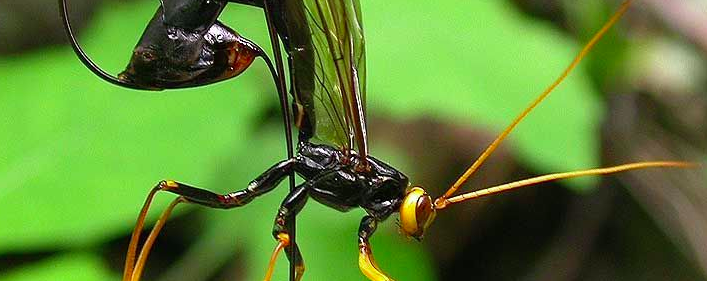
This insect looks like a large, slender wasp . Its head is yellow with a dark stripe between the eyes. The thorax and abdomen are dark, black or black-brown. The dominant color of the long legs is yellow. The four wings, elongated and narrow, are almost black.
The female has an impressive dark brown ovipositor measuring 12 to 15 cm long.
This species resembles two other rhysses found in the same habitat in Quebec. These are Cinnamon Rhysse ( Megarhyssa macrurus ) and Green Rhysse ( M. greenei ). You can recognize blackish rhysis by the brown-black color of its abdomen. In addition, this species has the longest ovipositor.
Life cycle
The blackish rhysis is an ectoparasitoid, that is, it needs a host to complete its life cycle, it is an external parasite (it does not live inside the host) and that it kills its host during its growth.
In Quebec, adults fly from May to September. They live for about 27 days, during which they mate. The female then searches for a host on which to lay eggs. It is often the larva of the tremex ( Tremex columba ). This one lives in the wood, and the female uses her long ovipositor to reach it. The young rhysse feeds on its host during its four larval stages. It then transforms into a pupa, and then emerges externally as an adult. The life cycle lasts about two years.
Geographical distribution
This species is found in southeastern Canada, as well as northeastern and central United States.
Habitat
This insect lives in environments made up of deciduous trees.
Food
The larva of this species derives its nutrients from the body of its host insect, usually the tremex , the larva of which burrows into the wood. Rhysse lays each of its eggs directly on a host larva. A living pantry is sufficient for the development of the rhyssa larvae.
Adults do not feed.
What you need to know
Little is known to scientists about the means of spotting tremex larvae by females. Among the hypotheses stated, it is possible that the olfactory or sound signals emitted by the prey are picked up by the antennae of the females who then manage to locate them precisely. During the laying, the female pierces the wood with her ovipositor to the larva. This action can last an hour which makes the immobile insect very vulnerable to predators.
It is not uncommon to find ovipositors stuck in the wood after an attack by a bird, a small mammal or another insect. Females also die because they fail to remove their ovipositor from the tree after spawning.
Ecological roles
The black rhysse acts as an agent of limitation of the populations of Tremex columba by parasitizing its larvae. It is also used for this purpose in biological control.
Although the tremex mainly digs its tunnels in weakened or dying trees, it can inflict damage by introducing fungi during egg laying which invade the vessels of the wood. For this reason, T. columba is sometimes considered a forest pest.
Ichneumons
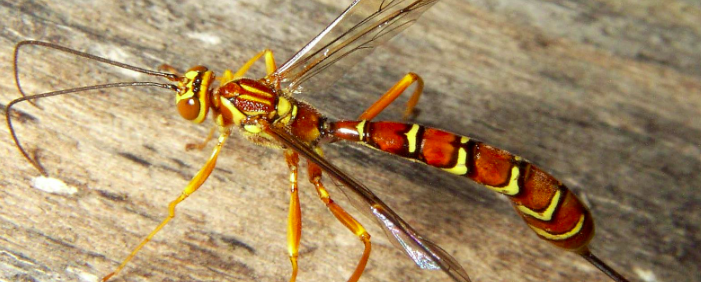
These insects generally resemble wasps , but they are distinguished by longer, more segmented antennae.
In several species, the abdomen of females ends in a long filament that exceeds the size of their body. This egg-laying organ is called an ovipositor.
The vast group of ichneumons consists of thousands of species that vary widely in size (3 to 50 mm in length) and coloring. Many have a uniform shade, varying from yellowish to black, while others feature two-color patterns: black and brown or black and yellow.
Life cycle
The female lays her eggs on or in living insects. She can choose caterpillars, pupae or chrysalis .
The host serves as a pantry for the young insect emerging from the egg. The ichneumon larva transforms into a pupa after having devoured almost entirely the body of its host. The insect spends some time in this motionless form, then the adult emerges.
Many ichneumons hibernate as adults, hidden under bark or under fallen trees.
Habitat
These insects are common in several habitats. They are found almost everywhere in the world.
What you need to know
Ichneumons are classified as parasitoids because their larvae complete their development by feeding on a host that eventually dies (in the case of parasites, the host does not die). More precisely, these insects are ectoparasitoids when they live on the body of their host, or endoparasitoids when they live in the body of their host.
There are even ichneumons that parasitize other parasitoid insects inside their host. They are hyperparasitoids.
About 3,300 species of ichneumons are recorded in North America. There are an estimated 60,000 species worldwide.
The largest ichneumons in North America are part of the genus Megarhyssa and can be up to 2 inches long.
Ecological roles
These insects parasitize a wide variety of hosts, usually immature stages (larvae, caterpillars, pupae) of insects, including Lepidoptera, Coleoptera and Hymenoptera. Some also attack spiders and other arthropods .
Ichneumons are considered beneficial because they play an important ecological role in helping to balance arthropod populations .
Bicyrtes quadrifasciatus – Bicyrt wasp – Burrowing wasps
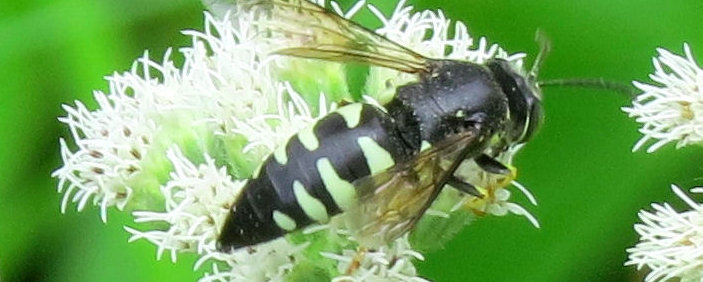
This black wasp has whitish or pale yellow, interrupted bands in the middle of the abdomen. The width of these lines decreases towards the tip of the abdomen. Its legs are clear and its wings amber or greyish. It measures 17 to 19 mm long.
Life cycle
The solitary female digs her nest in sandy soil. She goes hunting and brings back to the underground shelter a paralyzed prey that will serve as food for the larva. It lays an egg on this prey and then blocks the entrance to the burrow with sand. The larva feeds and transforms into a pupa in a cocoon before emerging as an adult.
Geographical distribution
It is a North American species.
Habitat
This wasp is found in open sandy areas. In urban areas, it can establish itself in playgrounds, parks, sandboxes, etc.
Food
The adult feeds on flower nectar.
The larva feeds on the preys captured and paralyzed by the female. These are usually immature bedbugs such as the green bug, pentatomid, pine bug, coreid, and other species of redbugs.
What you need to know
Along with the American bembex, this insect is one of the two most common sand wasps in Quebec. In some years, both species are common in city parks and playgrounds where sand-covered surfaces are found.
Ecological roles
Adults help pollination by carrying pollen from flower to flower as they feed on nectar.
Certain species of parasitoid flies lay their eggs on the larvae present in the nest, thus making it possible to control the populations of this burrowing wasp.
Bembix americana – Burrowing insects
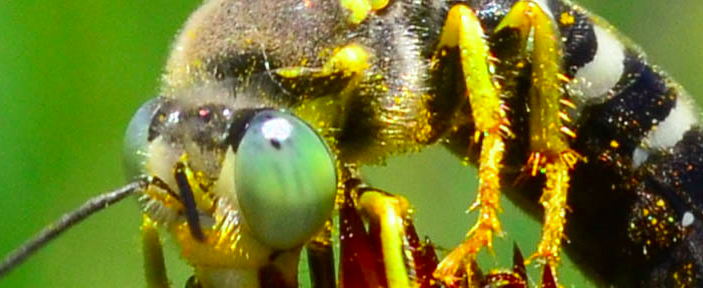
This black wasp has greenish yellow stripes on its abdomen . Its legs are yellow, except for the part closest to the body. Its wings are transparent, with brown veins. It measures 13 to 16 mm long.
Life cycle
The solitary female digs her nest in sandy soil. She goes hunting and brings back paralyzed prey to the underground shelter that will serve as food for the larva. She lays an egg on one of the prey, then blocks the entrance to the nest with sand. The larva feeds, develops and transforms into a pupa in the nest before emerging as an adult.
Geographical distribution
This species is found throughout North America, except in the west, on the Pacific coast.
Habitat
This wasp lives in open sandy environments, such as the edges of lakes, beaches or sandy meadows. In urban areas, it can nest in playgrounds, parks, sandboxes, etc.
Food
The adult feeds on flower nectar.
The larva feeds on various species of flies from the tabanid family ( Chrysops ) and bombyliides, captured and paralyzed by the female. This one sees to the supply of its offspring by depositing fresh preys in the nest approximately every five days. The female bembex can capture up to 20 preys to feed a single larva.
What you need to know
This insect very quickly digs its burrow in the sand and disappears there in a few seconds.
The female Bembex often excavates several nests not far from each other. However, she only uses one or two at a time for her larvae. The additional nests could be a diversion for predators or parasites.
Along with the bicyrt wasp , this insect is one of the two most common sand wasps in Quebec. In some years, both species are common in city parks where sand-covered surfaces are found.
Ecological roles
This wasp species is a predator and plays an important role in controlling fly populations.
Burrowing wasps

These insects vary in size and have the characteristic thin size of wasps . They are all able to sting with a sting located at the end of their abdomen and hunt alone.
The larvae do not have legs.
Crabronids were recently included in the Sphecid family , wasps quite similar in appearance and behavior. Crabronids are now considered a family in their own right.
What you need to know
This family has about 8,800 species divided into 240 genera around the world.
The larva feeds on a wide variety of preys captured by the female. Preys are paralyzed by venom injected with a sting, a modified egg-laying (ovipositor) organ.
Some wasps belonging to the philanthine subfamily nest in groups and show the beginnings of a division of labor.
There are two common species in Quebec belonging to the crabronid family. This is the bicyrtes wasp and Bembex of America .
Life cycle
After mating, the female builds her nest in the sand and then captures insects or spiders that she paralyzes with her venom. It transports them to the nest, then lays its eggs on the prey which will serve as food for the larvae.
Some species are kleptoparasites: females use the nest of another wasp and lay eggs on preys already captured. They abandon their eggs and take no care of their larvae.
Habitat
Several species make their nests in the ground, some in pre-existing cavities or in stems while others make it with mud and shape it into a tube.
Food
The prey captured not adults cover a wide variety of orders of insects, spiders and mainly the order of the Araneae .
Social wasps
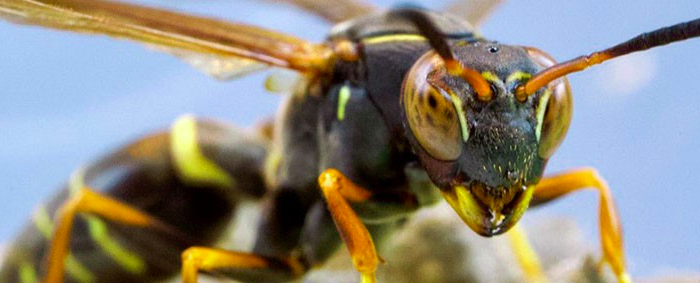
Social wasps are insects whose size is marked by a constriction between the thorax and abdomen. Workers have a sting at the end of their abdomen .
There are two subfamilies of social wasps in Quebec. Vespines, or true wasps, are black with yellow or yellowish-white markings on the abdomen, face, or thorax. Polistines are brown and have long legs.
Life cycle
The colony is founded by a queen who was impregnated the previous year and spent the winter in the shelter. She begins building the nest and takes care of the first larvae from her eggs. These, having become adults, constitute the first generation of workers. They continue to build the nest and take care of the queen and the new larvae.
Social wasps establish their colony in paper nests or underground nests, some of which can house thousands of individuals. The nests are also called bee-eaters.
At the end of summer, male individuals are produced. They mate with future queens to ensure the formation of new colonies the following year. In our climates, only fertilized queens survive the winter. Workers and males die with the onset of cold.
What you need to know
Worker wasps feed the larvae with various chewed insects and other sources of animal protein. They themselves eat sugary substances. When they come to rest on our food, they are in search of one or the other of these foods.
Equipped with a sting, wasps sting to defend themselves or to defend the colony. The venom injected during the bite also serves to paralyze their prey, which can thus be kept alive in the nests.
In our latitudes, the nests of paper wasps are not reused and workers build new ones every year. There are two types of paper nests. Those of the wasps of the vespine subfamily are covered with paper and have an opening at the base. They can be very big. These bee-eaters have several rows of cells where the larvae develop. They are often seen hanging from houses, but they can also be hidden in trees.
The nests built by the wasps of the polistine subfamily (the polistines) are open, revealing the cells, and are always suspended at the end of a small rod. Smaller in size, they have only one row of cells, all open at the bottom.
The paper used for the preparation of the nests is made of a paste made up of vegetable fibers mixed with the saliva of the wasps. Its color varies depending on the source of the fibers: wood, bark, stems, cardboard, etc. Different species of wasps may have preferences regarding the fibers used.
It was by observing the behavior of wasps that the French naturalist Réaumur had the idea, in 1720, to use wood fibers to make paper. At that time, Europeans made their paper with rags. A hundred years later, wood-based paper made its appearance.
Ecological roles
Workers are predators of other insects.